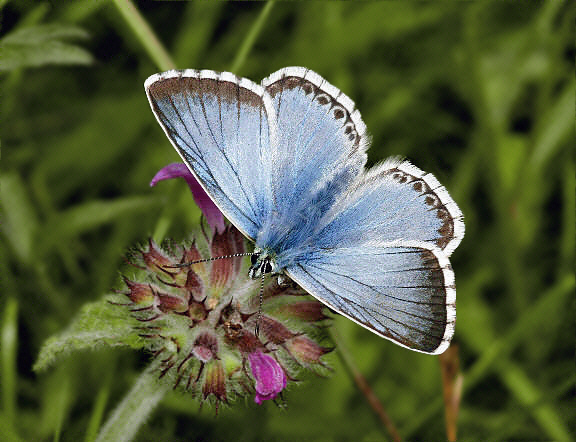 Chalkhill Blue Polyommatus coridon, male, Magdalen Hill Down, Hampshire – Adrian Hoskins
Chalkhill Blue Polyommatus coridon, male, Magdalen Hill Down, Hampshire – Adrian Hoskins
Introduction
The taxonomy of the genus Polyommatus has recently been revised so that it now includes those species formerly placed in Lysandra, Neolysandra, Sublysandra, Plebicula, Elviria, Rimisia, Bryna, Meleageria, Agrodiaetus, Paragrodiaetus and Cyaniris. Defined thus Polyommatus comprises about 220 species, distributed variously across Europe, North Africa, temperate Asia and North America.
A freshly emerged male Chalkhill Blue is a particularly beautiful insect, with shimmering silvery blue wings, and long hair-like scales adorning the body, giving it a distinctly furry appearance. The wings are highly reflective so the butterfly appears to be silvery when seen in bright sunshine.
The female can be confused with the female Adonis Blue bellargus, but the upperside of the latter is a deeper chocolate colour. It also has blue edging to the black sub-marginal spots on the upperside, as compared to whitish edging in coridon. The emergence of the 2nd brood of bellargus overlaps slightly with coridon during August, and both species often share the same habitats.
The Chalkhill Blue is distributed across much of Europe, but absent from northern Britain, Ireland, northern Scandinavia, Portugal, southern Spain and most of the Mediterranean islands. Its range extends into western Asia as far as the Ural mountains.
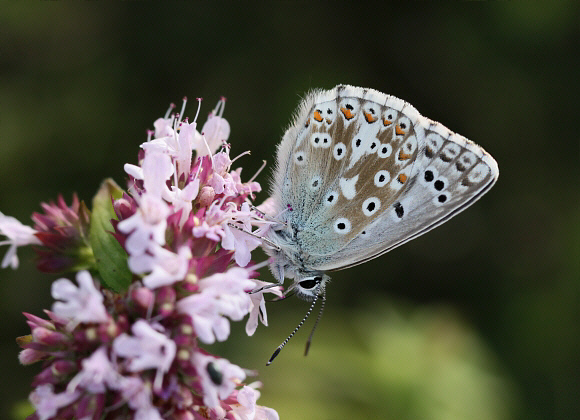 Chalkhill Blue Polyommatus coridon male, Lardon Chase, Berkshire – Adrian Hoskins
Chalkhill Blue Polyommatus coridon male, Lardon Chase, Berkshire – Adrian Hoskins
Habitats
This butterfly breeds on chalk and limestone hills, and favours south facing slopes where the larval foodplant horseshoe vetch grows profusely among fine grasses. The greatest numbers occur on sites that are lightly grazed by sheep, cattle or rabbits. At the best sites the butterfly can occur in thousands, but it can also survive at quite low densities at sites where grazing has been abandoned and the grasses grow tall. At such sites they breed in areas where the foodplant grows at the edge of paths, on patches of scree, or abutting rabbit scrapes.
Colonies are very localised, but not to the same degree as those of the Adonis Blue. Thus coridon may be found spread widely across its sites, whereas bellargus is usually restricted to tiny strips of land where the microhabitat is particularly warm. Stray males can be found irregularly up to 8kms from the breeding sites, sometimes in quite unsuitable habitats such as woodland clearings. Female strays are almost unknown, and it is extremely unusual for this species to colonise areas away from its regular breeding sites.
 Chalkhill Blue Polyommatus coridon male, Lardon Chase, Berkshire – Adrian Hoskins
Chalkhill Blue Polyommatus coridon male, Lardon Chase, Berkshire – Adrian Hoskins
Lifecycle
This species is single brooded, with a protracted emergence beginning in early July and continuing into late August, with the last individuals often seen well into September.
The reticulated, dome-shaped whitish eggs are laid singly on stems of horseshoe vetch Hippocrepis comosa or on nearby grass stems in August. During the winter they are washed off by the rains and lie on the surface until the spring. The larvae are fully formed within the eggs in the autumn, but do not hatch until the following March or April.
The plump green larva is marked with broken yellow lines along its back and sides. It rests under stones or chalk fragments during the daytime, and feeds nocturnally. It can be found easily at dusk, when large numbers of ants are in constant attendance. Ants will sometimes grab hold of a larva to carry it closer to their nest, milking it to obtain the sugary secretion exuded from its honey glands. In return for their reward, the ants protect the larva against wasps and bugs.
The pupa is a dirty greenish colour, and is formed on the surface of the ground. Like the larva, it exudes secretions to attract ants. The ants hide the pupa, covering it with tiny fragments of earth, and guarding it against attacks by other insects. The gaps between the abdominal segments of the pupa are armed with opposing sets of microscopic serrations that can be rubbed together to create a rasping sound. Just prior to emergence the butterfly within the pupa ‘sings’ to attract ants, which cluster around it, inadvertently protecting it from predatory insects and arachnids. The ants never attack the emerging butterfly, seemingly appeased either by the song, or possibly by a pheromone.
 Polyommatus coridon, male drying wings after emergence, Stockbridge Down – Adrian Hoskins
Polyommatus coridon, male drying wings after emergence, Stockbridge Down – Adrian Hoskins
Adult behaviour
The butterfly, when it emerges in July, has to break through the soil and find its way to a stem from which it can hang to dry its wings. The adults often emerge en masse, and can sometimes be found basking in hundreds on low herbage early in the mornings.
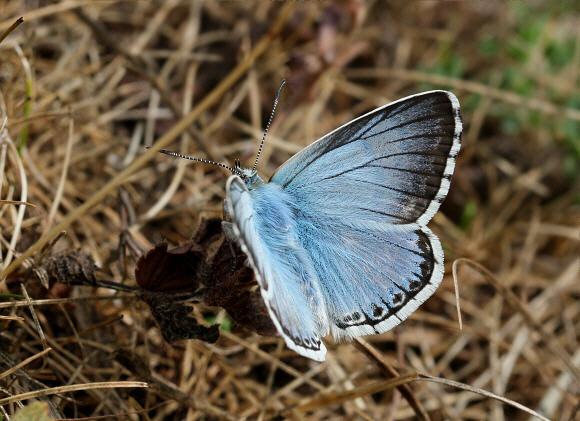 Chalkhill Blue Polyommatus coridon male, Lardon Chase, Berkshire – Adrian Hoskins
Chalkhill Blue Polyommatus coridon male, Lardon Chase, Berkshire – Adrian Hoskins
Favourite nectar sources include marjoram, stemless thistle, carline thistle, knapweeds, wild basil, self heal and thyme, although they will also visit bramble, ragwort, yarrow and hemp agrimony. They also occasionally gather in small groups on mammal dung.
In the French Alps I have often seen males congregate in thousands to drink at patches of mud or urine-soaked soil. Often there are several other species present at these gatherings including Essex Skippers, Large Grizzled Skippers and Heath Fritillaries, but each species polarises towards its own kind, thus the Chalkhill Blues will cram very tightly together in one spot, and the Essex Skippers etc will form their own equally tightly packed groups just a few centimetres away.
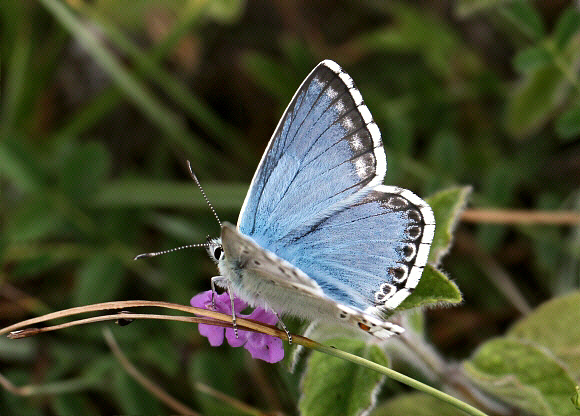 Chalkhill Blue Polyommatus coridon male, Lardon Chase, Berkshire – Adrian Hoskins
Chalkhill Blue Polyommatus coridon male, Lardon Chase, Berkshire – Adrian Hoskins
In southern Britain one of the commonest predators of butterflies is the spider Enoplognatha ovata, a member of the family Theridiidae. This small species traps summer butterflies which fly into the sticky strands of an untidy web which it spins on grass-heads and wild flowers. I made a brief study of predation at Magdalen Hill Down in Hampshire in mid-July 2009 and estimated that a minimum of 5 percent of the population of Chalkhill Blues fell victim to this spider.
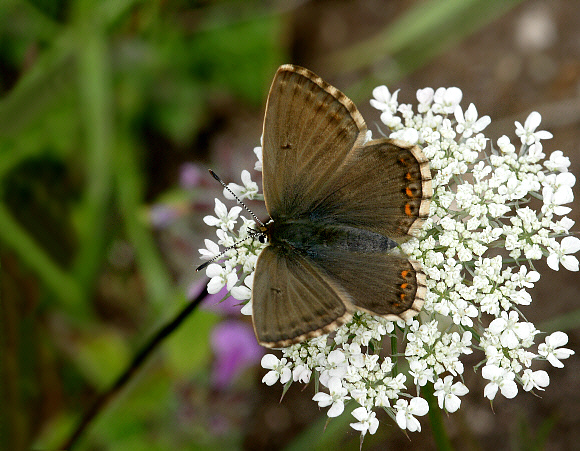 Chalkhill Blue Polyommatus coridon, female, Stockbridge Down, Hampshire – Adrian Hoskins
Chalkhill Blue Polyommatus coridon, female, Stockbridge Down, Hampshire – Adrian Hoskins
As dusk approaches the butterflies migrate to a sheltered part of their habitat, often at the the base of a hill where they roost over-night on plantain flowerheads, knapweeds or tall grasses. Sometimes several males share a single grass head, all adopting a head-downwards posture.
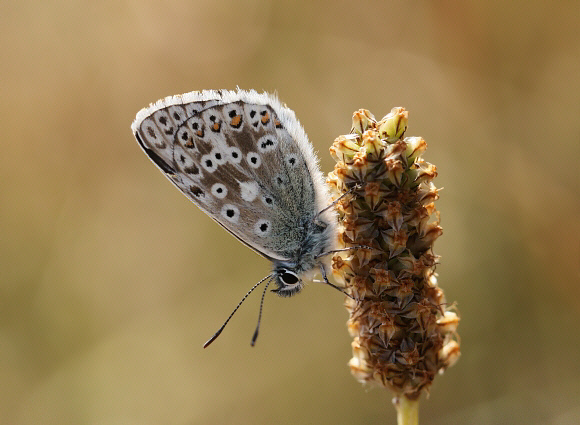
Chalkhill Blue Polyommatus coridon male, Lardon Chase, Berkshire – Adrian Hoskins
